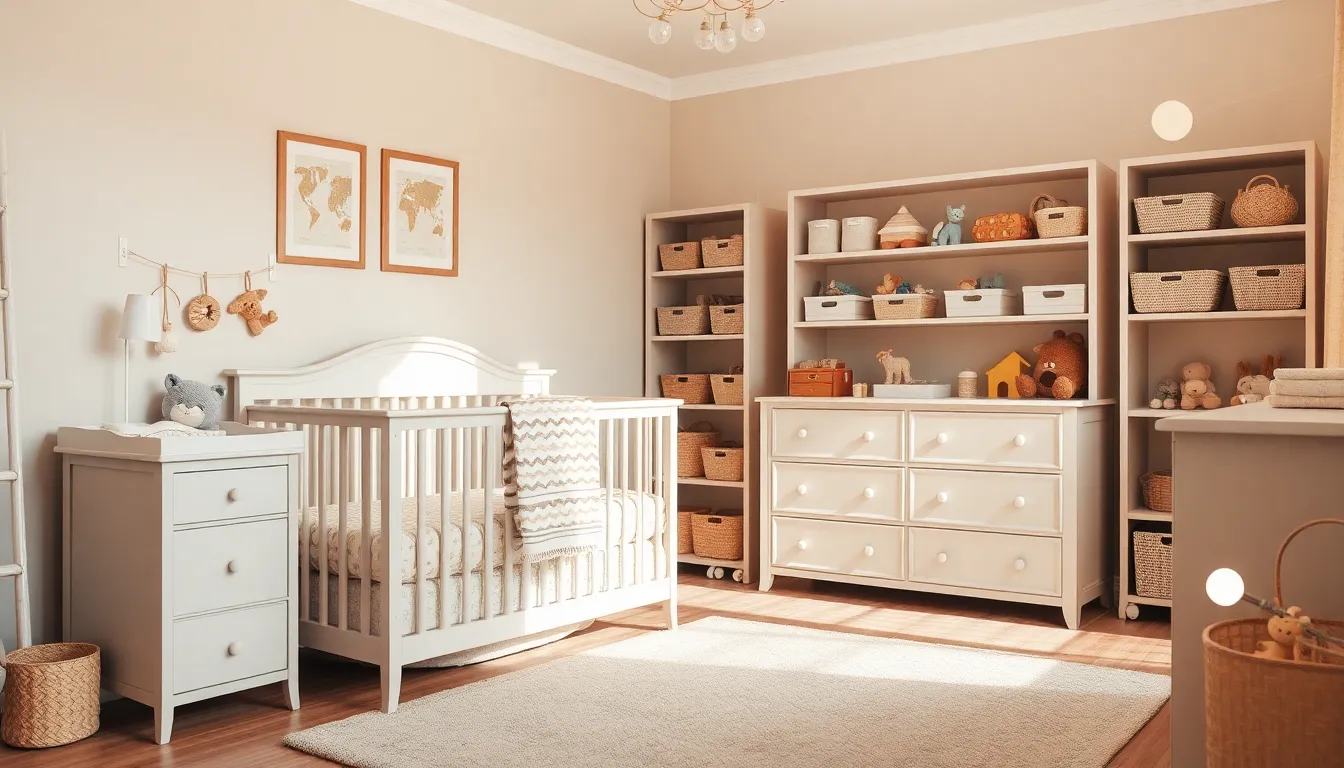Choosing nursery furniture is like picking the perfect outfit for your baby’s debut on Instagram. It’s got to be stylish, functional, and safe enough to withstand the inevitable chaos of tiny hands and even tinier feet. With so many options out there, it can feel overwhelming—like trying to find a needle in a haystack, but the needle is a crib that matches the nursery theme and the haystack is made of adorable stuffed animals.
Table of Contents
ToggleOverview of Nursery Furniture
Nursery furniture includes essential pieces such as cribs, changing tables, and storage solutions. Cribs serve as a safe sleeping space, and many options offer adjustable mattress heights for convenience. Changing tables provide a dedicated area for diaper changes, often including storage for wipes and diapers.
Storage solutions come in various forms, including dresser units and shelves. Dressers help organize baby clothes while shelves display toys and books, keeping the space tidy. Accessibility plays a crucial role in selecting furniture, allowing caregivers to reach items easily during daily routines.
Safety features remain a priority when choosing nursery furniture. Look for cribs certified by safety standards, ensuring they meet regulations. Each piece should have rounded edges and sturdy construction, minimizing risks for active toddlers.
Style shouldn’t be overlooked, as nursery aesthetics make an impact. Popular themes range from modern minimalism to whimsical designs, creating a welcoming atmosphere. Choosing a cohesive color palette enhances the overall look, tying all furniture pieces together.
Durability also factors into the selection of nursery furniture. Wood and sturdy composites create a long-lasting foundation that can withstand wear over time. Investing in quality materials ensures the furniture remains functional as the child grows, adapting to their changing needs.
Selecting nursery furniture involves balancing function, safety, and style. Expect a wide range of choices available, catering to various tastes and budgets. Prioritizing these elements leads to creating a nurturing and stylish space for both child and caregiver.
Types of Nursery Furniture

Selecting the right nursery furniture involves understanding various essential pieces that contribute to a safe and functional environment for a child.
Cribs and Cots
Cribs serve as the primary sleeping space for infants. With adjustable mattress heights, these cribs accommodate a growing baby’s needs. Safety is crucial; choosing cribs certified by safety standards minimizes risks. Some cribs convert into toddler beds, extending their usability. Cots, specifically designed for infants, are available in portable options, allowing for easier mobility between rooms.
Changing Tables
Changing tables create a dedicated area for diaper changes, ensuring convenience during busy routines. Many changing tables include storage options, keeping essential supplies within easy reach. Styles vary from compact designs to elaborate setups, accommodating different nursery layouts. Some models come with safety straps; ensuring the child’s safety during changes remains a top priority. Versatile changing tables transition into dressers, offering longevity beyond diapering years.
Dressers and Storage Solutions
Dressers and storage solutions maintain organization in a nursery. These pieces accommodate baby clothes, blankets, and toys in an accessible manner. Dressers often feature multiple drawers; organizing items efficiently prevents clutter. Shelving units provide display space for toys and books while keeping essentials within reach. Utilizing storage baskets enhances organization, making it easier for caregivers to streamline daily tasks. Investing in durable materials ensures these storage solutions endure years of use.
Materials Used in Nursery Furniture
Selecting the right materials for nursery furniture ensures safety and longevity. Common materials include wood and MDF, along with non-toxic finishes.
Wood vs. MDF
Wood provides natural beauty and durability for furniture. It stands out for its sturdiness and ability to resist wear over time. Cribs made from solid wood are often passed down through generations. On the other hand, MDF, or medium-density fiberboard, offers a cost-effective alternative. MDF comes with a smooth finish that suits various designs. While lightweight and easy to handle, MDF may not have the same longevity as solid wood. Price considerations often favor MDF for budget-conscious buyers. Real wood remains preferred by many for its aesthetic appeal and long-lasting quality.
Non-Toxic Finishes
Non-toxic finishes protect furniture and ensure a safe environment for children. Many manufacturers use finishes free from harmful chemicals. Water-based options are popular, as they emit fewer volatile organic compounds, enhancing indoor air quality. Low-VOC finishes maintain a safer atmosphere in the nursery. Parents often seek finishes that are easy to clean while remaining environmentally friendly. Chemical-free coatings ensure surface safety, particularly for teething babies. Eco-conscious options exist, allowing caregivers to prioritize both health and style in their furniture choices.
Safety Considerations for Nursery Furniture
Safety remains a top priority when selecting nursery furniture. Cribs certified by safety standards such as ASTM or CPSC ensure that the baby’s sleeping environment is secure. Features like adjustable mattress heights complement a growing baby’s needs and reduce fall risks. Additionally, some cribs convert into toddler beds, extending their usability beyond infancy.
Changing tables should include safety straps. Secure features help prevent accidents during diaper changes. Many models also offer storage solutions for quick access to essentials, streamlining busy routines.
Dressers deliver organization but must have stable construction. It’s important to choose units that prevent tipping, ensuring safety during use. Multiple drawers help store baby clothes and toys efficiently, making daily tasks manageable.
Materials used in furniture construction significantly influence safety. Solid wood offers durability and natural beauty. However, MDF combines affordability with lightweight handling, making it an appealing choice for many. Non-toxic finishes, including water-based and low-VOC options, provide added safety, enhancing indoor air quality.
Rounded edges on furniture reduce injury risks for active toddlers. Consequently, selecting pieces with these safety features creates a nurturing environment. Attention to detail in design contributes to both aesthetic appeal and safety.
Finally, regular inspections of nursery furniture ensure everything remains in good condition. Checking for loose parts or wear helps maintain a safe space. By prioritizing safety, caregivers create both a stylish and secure nursery for their children.
Trends in Nursery Furniture Design
Modern nursery furniture designs focus on both aesthetics and functionality. Minimalist styles dominate, characterized by clean lines and neutral color palettes that create soothing environments. Soft pastels and monochrome hues remain popular for their versatility and ability to blend seamlessly with various themes.
Sustainable materials gain traction in the nursery furniture market. Manufacturers increasingly prioritize wood sourced from responsible forestry practices, promoting eco-friendliness. Alongside wood, bamboo emerges as a strong contender due to its rapid growth and durability.
Convertible furniture pieces offer practical solutions for growing families. Cribs that transition into toddler beds maximize value and reduce waste over time. Changing tables that convert into stylish dressers extend usability, allowing furniture to evolve with a child’s needs.
Safety remains paramount in design considerations. Features such as rounded edges, stable frameworks, and certified materials resonate with parents focused on creating secure spaces. Non-toxic finishes contribute to healthier indoor environments, as low-VOC options enhance air quality.
The incorporation of technology into nursery furniture also rises. Smart cribs equipped with sleep-assisting features and integrated sound machines appeal to tech-savvy parents. Adjustable lighting systems allow caregivers to create the perfect ambiance for different times of day.
Lastly, customizable furniture options increase personalization in nursery designs. Modular shelving systems enable parents to adapt storage solutions based on their evolving organizational needs. Personalized touches, such as custom paint schemes or unique hardware, further enhance individuality in nursery spaces.
Choosing nursery furniture is a significant step in creating a safe and stylish environment for a child. With numerous options available, parents can find pieces that not only meet safety standards but also fit their aesthetic preferences. From cribs that grow with the child to versatile changing tables and efficient storage solutions, each element plays a crucial role in daily routines.
Investing in high-quality materials and designs ensures longevity and functionality. The focus on safety features cannot be overstated, as they provide peace of mind for caregivers. Ultimately, the right nursery furniture harmonizes practicality with style, setting the stage for cherished moments in a nurturing space.


